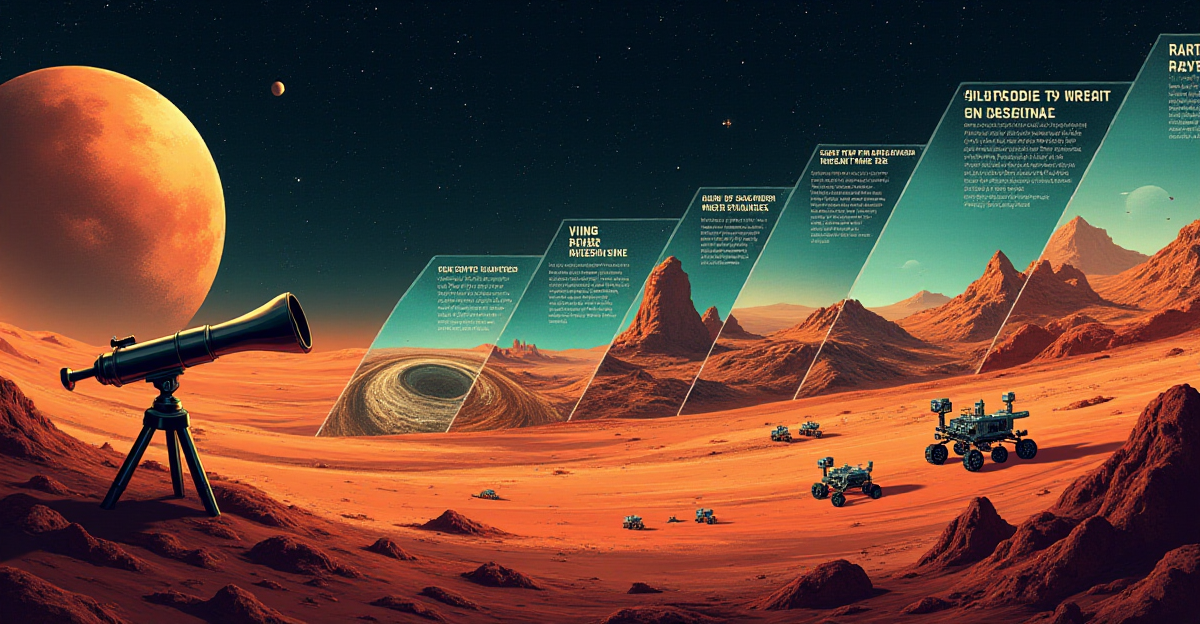Research the continuous search on Mars for water. Recent discoveries, the ramifications for life, and upcoming Mars missions targeted at investigating the watery past of the Red Planet are discussed in this article.
Table of Contents
- Historical Findings of Water on Mars
- Evidence of Water on Mars: A Journey Through Time
- Implications for Life on Mars
- The Water on Mars: Future Missions
- Extra’s:
Historical Findings of Water on Mars

Have you ever pondered if life exists elsewhere while you stared up into the nighttime heavens? Possibly even on Mars. We have always found great fascination in the Red Planet, and for years the prospect of Mars water enthralls us. Consider the ramifications should we prove evidence of prior water. It could suggest that Mars formerly had a suitable habitat, maybe even supporting life as we know it. Let’s travel through the fascinating history of water discovery on Mars, which has altered our perception of the Red Planet and its viability for life.
Early Observations and Theories: A Glimpse of Water
Early Mars observations suggested water was present. Giovanni Schiaparelli, an Italian astronomer, noted canals on Mars’s surface back in the 1870s, which spurred a lot of conjecture about an advanced society. Although these canals proved to be optical illusions, they stoked our passion about Mars. These early findings were a vital first step on a road that would finally produce revolutionary discoveries.
Mars drew us closer with the commencement of the space missions era in the 20th century. Dried-up riverbeds shown in the initial pictures returned from these flights suggested that water had flowed freely over the Martian surface. We seemed to be learning mysteries about Mars’s history. These results excited people about Martian exploration and the hunt for proof of former water.
The Viking Missions: A Major Breakthrough
With the arrival of the Viking missions, the 1970s represented a significant turning point in our understanding of Mars. These missions dispatched probes to Mars to provide us first-hand, finely detailed photos of its surface. Though the findings were not definitive, the Viking landers carried tests to hunt for evidence of microbial life. But a big discovery surfaced: the Martian soil was rather high in water ice. This discovery confirmed the theory that Mars’s past depended critically on water.
You could be asking how researchers found water ice present. Martian dirt was examined by the Viking landers using a gas chromatograph-mass spectrometer. This tool identified the chemical makeup of many substances split from the soil. The findings exposed water ice, therefore verifying that water existed on Mars in some capacity.
The Curiosity Rover: Unveiling Ancient Lakes
With the Curiosity rover arriving in 2012, our knowledge of Mars’s past entered still another fascinating chapter. For liquid water in the Martian past, this robotic adventurer discovered even more robust proof. Discovering sedimentary rocks created in ancient lakes, curiosity about Mars’s past warm and moist environment that might have supported life grew. Furthermore implying that Mars might have once been a livable planet, the rover also found evidence of organic molecules, the building blocks of life. These revelations vividly depicted a Mars unlike the desolate scene we know now.
Finding proof for past Mars water has transformed our knowledge of the Red Planet. Mars is today seen as a site with rich history, one that was somewhat different from what we know now. These findings have had a major impact on the astrobiology field, which investigates life outside Earth. Arriving in February 2021, the Perseverance rover is carrying on this heritage by looking for evidence of past life and gathering samples ready for study on Earth. This audacious goal is to shed more light on the possibility for life on Mars, a pursuit that has enthralled people for millennia. Martian exploration has many fascinating opportunities ahead of us, and we can only image what fresh discoveries will present.
Evidence of Water on Mars: A Journey Through Time

Have you ever pondered if there is water on Mars after staring up at the red dot in the nighttime heavens? For decades, this subject has enthralled researchers and space aficionados by inspiring innumerable missions and discoveries. Though later studies have shown convincing proof of water’s existence, both in the planet’s past and maybe today, early discoveries of canals on Mars were ultimately proven erroneous.
Let us go across time to investigate Mars’s water evidence. Imagine standing on the surface of the Red Planet and observing dried-out riverbeds all around. Among the first hints pointing to water on Mars are these old riverbeds.
Initiated in the 1970s, the Viking mission landed on Mars and examined the ground to offer more evidence. The Viking landers found large concentrations of water ice under the Martian surface, therefore confirming the presence of water on Mars in some form.
The Curiosity Rover’s Discoveries
When the Curiosity rover set down on Mars in 2012, our knowledge of Martian history underwent a major change. This robotic adventurer found sedimentary rocks created in prehistoric lakes, suggesting that liquid water formerly ran freely on Mars.
The Curiosity rover also found organic molecules, the building blocks of life, in these rocks, therefore generating the fascinating prospect that Mars might have once been habitable. This find spurred more investigation on the prospect of life on Mars.
Searching for Present Water
Though most of the water on Mars most certainly exists as ice, especially in the large polar ice caps, researchers are actively looking for proof of liquid water. Some researchers think liquid water could lie beneath the Martian surface, maybe in a layer of permafrost or in subterranean aquifers.
“Dark streaks on Martian slopes” that show up in warmer seasons and vanish in colder seasons also captivate scientists. Though more study is required to validate this hypothesis, these streaks—known as Recurring Slope Lineae (RSL), are thought to be generated by the flow of saltwater.
Currently roving Mars, the Perseverance rover is gathering samples destined for study back on Earth. These materials might offer more hints about past life on Mars. As we keep exploring the Red Planet, we should anticipate even more fascinating finds on water on Mars and the prospect of life outside Earth.
Implications for Life on Mars

Picture looking up at Mars in the nighttime sky. This is a world of mystery painted on a red and rust-colored canvas. But supposing that world was not always so barren? Imagine if billions of years ago Mars was a place where water flowed freely, sculpting rivers over the dusty terrain, and even housed the building blocks of life. Thanks to an amazing discovery—evidence of water on Mars—this fascinating possibility has grown increasingly apparent.
For our knowledge of Mars, this discovery is a major breakthrough that inspires fresh awe and possibility. It implies that Mars might have been a planet fit for life once. Imagine the ramifications: could we be by ourselves in the cosmos? Alternatively may there be other kinds of extraterrestrial life existing somewhere, maybe on Mars?
Could Mars Have Hosted Life in the Past?
Space missions such as Curiosity and Perseverance have discovered convincing data that Mars was once a far wetter and warmer planet. Scientists have discovered sedimentary rocks, old lake beds, and even organic molecules—the fundamental components of life as we know it. The ancient lakebed the Curiosity rover discovered was originally freshwater-filled, suggesting an era of maybe livable conditions. These finds expose a quite different Martian scene from the one we know now.
Exploring the Possibility of Life Today
Although Mars is a hostile and desolate planet nowadays, microbial life is still theoretically possible. Scientists think liquid water may lie under the Martian surface, maybe in subterranean aquifers or perhaps within a layer of permafrost. Even in these harsh environments, this latent pool of water could be able to maintain microbial life.
Often referred to as seasonal flows, dark streaks shown on Martian hillsides during warmer seasons are thought to be produced by salted water flows. This phenomena implies, although in a restricted and ephemeral form, liquid water may exist on the surface of Mars. Finding these flows has excited and intrigued scientists researching astrobiology in fresh ways.
Driven to investigate and comprehend the cosmos around us, the scientific search for solutions about the possibility of life on Mars pushes us. Deciphering this riddle depends on space missions like as Perseverance and upcoming schemes to return Martian material back to Earth. Deeper exploration of Mars’s mysteries might help us to ultimately know whether we are indeed alone in the huge cosmos.
The Water on Mars: Future Missions

Finding water on Mars has revolutionized our study of the Red Planet. It’s not just the existence of water itself, but also what it represents for the prospect of life. This find has spurred fresh space missions aiming at comprehending Mars’s past, present, and future.
Imagine staring at a scene shaped by past rivers and oceans while standing on Mars’ surface. This is the question that drives the enthusiasm about next Mars missions. Once abounding with water, we all wonder if this planet could have also supported life?
Unveiling Mars’s Secrets: Future Missions
The water discovered on Mars and its ramifications for astrobiology will take front stage in the next phase of inquiry. Aiming to address some of mankind’s most important concerns, these missions are stretching the bounds of science and technology. Could life arise in the recesses of Mars? Regarding next human missions to Mars, what does this discovery imply?
As the Mars exploration keeps solving the riddles of the Red Planet, we are poised for revolutionary findings.
Sample Return Missions: Bringing Mars to Earth
The Perseverance rover is assiduously gathering Martian rock and soil samples for return to Earth. Imagine the excitement of finding proof of past life on Mars! Knowledge of this would help you what?
Equipped with an array of tools meant to hunt traces of past life, the Perseverance rover is Among these tools are a camera to capture high-resolution photographs, a drill to gather Martian rock and dirt, and a laser to melt rocks and examine their composition. These samples will be kept in tubes and finally recovered from a future expedition and returned to Earth.
Exploring Subsurface Water: Searching for Hidden Oceans
Future missions will look at the prospect of liquid water existing beneath Mars’s surface, maybe in layers of permafrost or in subterranean aquifers. To find and investigate these latent water sources, these flights will make use of modern technologies like seismic sensors and ground-penetrating radar. Investigating these water reserves will provide us important new perspectives on Mars’s hydrological cycle and possibilities to sustain life, past or present.
Preparing for Human Exploration: A New Frontier
It’s making me thrilled since the idea of human missions to Mars feels more near than ever! But getting them there responsibly and sustainably calls for much planning. We must learn to produce resources on Mars, devise plans for living and working on the Red Planet, and grasp the difficulties of long-term space flight. To this endeavor, studying water on Mars is essential. We can investigate the water resources of the earth, evaluate their possibilities for sustaining life, and even create plans for their use to support upcoming human communities.
Making human exploration of Mars a reality will depend much on these next expeditions. They will challenge our knowledge of the Red Planet and open the path for a fresh phase of interplanetary discovery. Examining water on Mars will help us to grasp the cosmos and our place within it.
Extra’s:
If you’re fascinated by the search for water on Mars, you might also be interested in exploring other scientific frontiers. Our post, “The Science Behind Edible Insects: Nutrition and Sustainability,” delves into the potential of insects as a sustainable food source, a topic that shares a similar focus on exploring alternative resources. And for a deeper dive into the psychological impact of color on our daily lives, check out our article, “The Psychology of Color in Everyday Life.” This article explores how color influences our emotions, behaviors, and perceptions, offering another fascinating perspective on the human experience.
To learn more about the history and scope of Mars exploration, we recommend visiting “Every mission to Mars ever | The Planetary Society.” This comprehensive resource from The Planetary Society provides a timeline of all missions to Mars, offering insights into the challenges and successes of this ambitious endeavor. For a detailed overview of the current scientific understanding of water on Mars, we suggest “Water on Mars – Wikipedia.” This Wikipedia entry provides a thorough analysis of the various forms of water on Mars, including its distribution, potential sources, and implications for future exploration.












1 thought on “The Search for Water on Mars: A Comprehensive Guide”